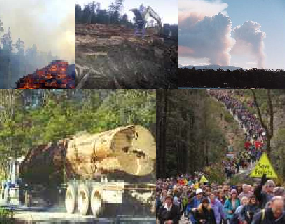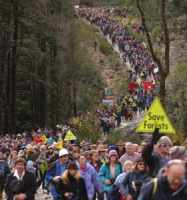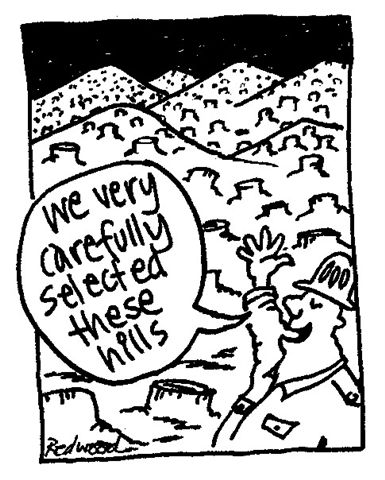Mood:
Topic: ecology
Prof Allan Fels is determined to stir up various hornet nests in some kind of profile build this last 3 weeks, as here:
Sent: Monday, May 19, 2008 3:14 PMSubject: fels profile build Re: [chipstop] Letter in response to Fels, Brenchley NAFI propagandaI think this article of mine a week back might be relevant to Fels postures on anything vaguely pro industry at the moment from easier approval of shopping centres (see World Today show 19 May 08), to sloppy analysis of logging industry on greenhouse as per Harriet here, or as here big banks:Tuesday, 13 May 2008Prof Allan Fels profile build to stalk Graeme Samuel's ACCC job?
Mood:d'oh
Topic: aust govtand then there is this pretty overt attack on firstly Howard ex regime but also Graeme Samuels here, again with AFR ex editorSo much for reining in big business | businessday.com.au
Allan Fels and Fred Brenchley; May 3, 2008 ... Even the chairman of the Australian Competition and Consumer Commission, Graeme Samuel, appears at sixes and
Yep, Allan Fels is making himself a real pain in the butt all over the place but probably insinuating himself very effectively with the Rudd machine?
This was the latest source of aggravation about loud mouth Allan Fels and his mate former editor of the AFR Brenchley:
Sent: Monday, May 19, 2008 12:51 PMSubject: [chipstop] Letter in response to Fels, Brenchley NAFI propagandaHi greenies
Letter in response to Fels, Brenchley NAFI propaganda
Letter to the Editor
So, the forestry industry is “greening up its act.” (SMH 17-18/5:45,47). If we read between the lines of the National Association of Forest Industries(NAFI)’s latest piece of self serving propaganda repackaged as “climate friendly,” we see they want to continue woodchipping our forests and count them as carbon sinks, too.
Under the Kyoto protocol, of course, they can. Kyoto doesn’t distinguish between a 500 year old forest and a six month old regrowth.
But NAFI doesn’t just want business as usual; it also wants a pulpmill and is asking the Government to redefine its old dream of burning native forests for fuel as “clean and renewable.”
If it seriously thinks this will “end Australia’s emotional debate over logging and even woodchipping” it is mistaken.
Harriett Swift
Have a read of this business horror story here (and yes we do mean you Prof Fels, Brenchley):
Some policy rhetoric in a response to the lines in the Fels/Brenchley article.
- The 1992 National Forest Policy Statement was a set of weasel words used to summarise the excellent Commonwealth Resource Assessment Commission 1992 Forest and Timber Inquiry Final Report of March 1992. The RAC was headed by Justice Don Stewart formerly of the National Crime Commission appointed by Bob Hawke. His chief of research was one Clive Hamilton. Keating as new PM had no love of Hawke creations and RAC was soon disbanded.
- The findings of RAC included, to paraphrase 'that no example of ecologically sustainable native forest logging was identified anywhere in Australia'. This was not for lack of searching. They do not exist because logging is highly mechanised, destroying canopy, dominated by high intensity woodchipping to transform the public land into pseudo plantation for private profit. All aided and abetted by corrupt accounting within state forest agencies.
- The bipartisan NSW Parliamentary Public Accounts Committee of 1990 found for instance that profits from plantations were being channeled into the loss making native forest sector at considerable lost public revenue and lost public heritage. The PAC recommended the NSW Forestry Commission be split into two parts to prevent this covert cross subsidy. In NSW the agency was simply rebranded as 'State Forests'.
- The so called Regional Forestry 'Agreements' of the late 90ies involved state to federal govt agreement with industry but never had consent of the public, represented by reputable polling against woodchipping or non government group membership representing some million or more Australians. In this sense the RFAs are a fraud on the public by special interests in Canberra and highly paid PR operations.
- perhaps the worst ongoing impact of this high intensity logging from a general public perspective is that huge swathes of landscape have been dried out due to disruption of humidity preserving canopy in natural forest. This is a recipe for megafire upon ignition. A megafire scenario aided and abetted by intensified woodchip driven logging.
- The emerging profitable plantation estate was evident as early as 1990-91 and was already underway well before the official tax incentivised 'forestry managed investment schemes'. The greater agri efficiency of plantation timber was out-competing hunter gatherer native forest logging as per published economic analysis of Judy Clark (later known as Judith Adjani) at that time. Out competing and replacing native forest logging. By 2000 it was clear that, in both volume of timber and jobs, plantations completely dominate the sector making the native forest sector look a niche cottage sector - apart from massive clearing via woodchipping to annexe public land. For instance a story "CSR, Boral form vehicle for sawmill operations" By Damon Kitney in the Australian Financial Review, p27 17th February 2000, indicates:
- The MIS tax breaks accelerated the plantation domination, but also the traditional industry desire to clear and annexe as much public forest estate for higher efficiency plantation, as rent seekers of free land rather than establishment on existing cleared land. This has been a grotesque market distortion and public subsidy exploiting our water catchments and natural carbon store to lazy but politically powerful special corporate interests always interested in more free land of sufficiently high rainfall profile. The greed of private interests at the expense of the public estate in this respect is grotesque. For Fels to lend his weight to this agenda is a betrayal of his own principles.
- For Prof Fels to endorse the NFPS of late 1992 as good competition policy is an insult to the RAC report earlier in 1992. Indeed Clive Hamilton spoke at a public rally in the Domain in Sydney around 1994 about the attack on our sovereign democracy by narrow corporate interests trying to annexe public forest for private profit. And he was right. Fels and Brenchley completely misconceive the internal federal ALP Parliamentary politics of 1991-96 in the transition to the Keating years when anything Hawke pioneered was trashed. Or indeed the role of industry front group 'Forest Protection Society' funded by NAFI (not dis similar to Westfield's bogus 'community groups against rival shopping centre developers) that supported woodchipping of Old Growth mature public forest. The FPA was forced under threats of legal complaints under section 52 of the Trade Practices Act and/or rhetorical expose to change their name, which they did to Timber Communities Australia - that still supports woodchipping of old growth forest today.
- In short nothing NAFI submits in terms of natural forests in the public estate can be trusted and this pretty much reaches all the way back to the RAC report of 1992 and Keating's weasel words interpretation in the NFPS. In 1996 both the Australian Conservation Foundation and The Wilderness Society took the extraordinary step of repudiating the ALP under Keating and remaining neutral in the federal election of that year, not least for wanton public forest destruction, which allowed the Howard led Opposition to portray themselves as at least competitive on the environment.
This was true in the sense that both major parties were in a race to the bottom as seen most starkly in the corruption of landuse and govt process in Tasmania today over the Gunns Pulp Mill.
Prof Fels must recant to protect his own professional reputation.
Tom McLoughlin, Bsc/Llb hon
More context about those times relating to then Industry Minister John Button here:
On the actual merits of forest protection to preserve carbon store for climate protection this advert ran in the Canberra Times on the weekend of the 2020 Summit:Wednesday, 9 April 2008John Button's spirit at the 2020 Summit regarding forests: 'Woodchipping's a bastard of an industry'
Mood:crushed out
Topic: aust govt





